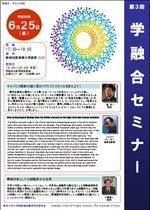AY2008 3rd Gakuyugo Seminar
- Date&Time:
- Jun 25, 2008 17:30~19:00
- Venue:
- Large Lecture Room (2C0), New Frontier Science Bldg.

Change Your Lifestyle with a Capacitor-Driven, Ultra-Compact EV!
Professor Yoichi Hori
Since electric vehicles are powered by electric motors, they have the following features: (1) torque response is two digits faster than that of an engine, (2) the torque generated can be accurately determined, and (3) the motor can be distributed. The electric double layer capacitor has the following features: (1) semi-permanent life, (2) rapid charging and discharging, (3) low environmental load of materials, and (4) residual energy can be determined from terminal voltage. Future cars will definitely be connected to the power system and run on the power of electricity and control. Capacitors are expected to back up the power system from the energy side. In the seminar, we will show various movies, so please look forward to it.

New archaeological findings from the fertile crescent: in the light of modern human evolution.
Visiting Associate Professor Joseph Kanjo
The fertile crescent today is one of the most important archaeological areas in the world, because many discovers had come in the last two decades. The archaeology discoveries showed the human societies started their life in this area hundreds thousands years ago; the first was the Homo erectus and later The archaeological discoveries showed the human societies started their life in this area hundreds of thousands of years ago; the first was the Homo erectus and later Homo sapiens. But the most important discovery in this area was the origins of sedentary life-style and the agriculture in the Neolithic period. This period produced many sites in this area and many innovations which were named as "the Neolithic revolution". Nowadays, many archaeological missions are working in this area (nationals and internationals), at least only in Syria around 135 missions. In my lecture, I want to show you some recent discoveries of excavations came from the middle In my lecture, I want you show some recent discoveries of excavations came from middle Euphrates in particular the new excavation results reported in the last two years. I am working for those missions: 1) Tell Qaramel, north Syria belong to I am working on those missions: 1) Tell Qaramel, north Syria belonging to pre-pottery Neolithic A, the most important discovery here is the first tower in the world, and human decapitation. 2) Djade Al Mughara, pre-Pottery 2) Djade Al Mughara, pre-Pottery Neolithic B, on the middle Euphrates river, we discovered the most ancient painting in the world, and human figurines (male and female). 3) Menbej tombs, Byzantine period: We found that the Herapolis (holy city) in Greek period and the Necropolis in Byzantine period. 4) Nabeka Mosaic, Byzantine period, the mosaic art came from fertile crescent before 9th century BC, with Assyrian culture. We found a large mosaic (50m2) which divided in two parts, geometric and natural design.

Application of supercritical water as an environmental technology
Professor Yoshito Oshima
In 2004, the world's first experimental waste treatment facility using supercritical water oxidation method started operation at Kashiwa Campus. Supercritical water, which has different properties from liquid or gaseous water, is expected to be one of the fundamental technologies to realize a sustainable society. In this seminar, the characteristics of supercritical water technology will be briefly introduced and the appeal of supercritical water as an environmentally friendly technology will be explained in an easy-to-understand manner.
*The contents of this page were developed based on a machine translation.

